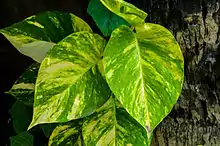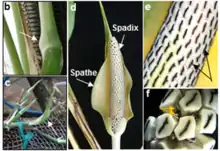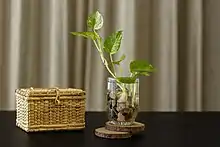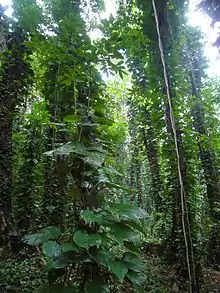Epipremnum aureum
Epipremnum aureum is a species of flowering plant in the arum family Araceae, native to Mo'orea in the Society Islands of French Polynesia. The species is a popular houseplant in temperate regions, but has also become naturalised in tropical and sub-tropical forests worldwide, including northern Australia, Southeast Asia, South Asia, the Pacific Islands and the West Indies, where it has caused severe ecological damage in some cases.
| Epipremnum aureum | |
|---|---|
 | |
| Cultivar ‘Golden Queen’ | |
| Scientific classification | |
| Kingdom: | Plantae |
| Clade: | Tracheophytes |
| Clade: | Angiosperms |
| Clade: | Monocots |
| Order: | Alismatales |
| Family: | Araceae |
| Genus: | Epipremnum |
| Species: | E. aureum |
| Binomial name | |
| Epipremnum aureum | |
| Synonyms[1] | |
The plant has a multitude of common names including golden pothos, Ceylon creeper,[2] hunter's robe, ivy arum, house plant, money plant, silver vine, Solomon Islands ivy, marble queen, and taro vine. It is also called devil's vine or devil's ivy because it is almost impossible to kill and it stays green even when kept in the dark.[3] It is sometimes mistakenly labeled as a Philodendron in plant stores. It is commonly known as money plant in many parts of the Indian subcontinent.[4][5] It rarely flowers without artificial hormone supplements; the last known spontaneous flowering was reported in 1964.[6]
The plant has gained the Royal Horticultural Society's Award of Garden Merit.[2][7]
History and etymology
This species has been assigned to a number of genera. In 1880 when it was first described, it was named Pothos aureus, which is in part why it is often commonly referred to as a "pothos". After a flower was observed in 1962, it was given the new name of Raphidophora aurea. However, after closer examination of the flower, researchers noticed its heightened similarity to Epipremnum pinnatum and synonymised it with that species. Only after further observations of all parts of the plant, including the leaves and growing patterns, was it again separated from E. pinnatum, as E. aureum.[8]
Description

Epipremnum aureum is an evergreen vine growing to 20 m (66 ft) tall, with stems up to 4 cm (2 in) in diameter, climbing by means of aerial roots which adhere to surfaces. The leaves are alternate, heart-shaped, entire on juvenile plants, but irregularly pinnatifid on mature plants, up to 100 cm (39 in) long and 45 cm (18 in) broad; juvenile leaves are much smaller, typically under 20 cm (8 in) long.
The flowers are produced in a spathe up to 23 cm (9 in) long. This plant produces trailing stems when it climbs up trees and these take root when they reach the ground and grow along it. The leaves on these trailing stems grow up to 10 cm (4 in) long and are the ones normally seen on this plant when it is cultivated as a potted plant.
Shy-flowering nature
While E. aureum is classified as an angiosperm, which typically produce flowers at some point in their life cycle, it is the only reported species in its family (Araceae) that does not develop a flower. Regardless of where this “shy-flowering” plant is grown or what the conditions are like, it will not flower due to a genetic impairment of the gibberellin (GA) biosynthetic gene, EaGA3ox1. This impairment causes the plant to be unable to develop bioactive GAs, which is what is responsible for the flowering of plants via the floral meristem identity gene EaLFY. In E. aureum, the floral meristem identity gene expression is absent due to the lack of GAs from EaGA3ox1. It was found that when GAs were experimentally sprayed onto the plant, flowering was induced.[8]
Distribution
Originally, it was endemic to the island of Mo'orea from the Society Islands. However, it is now wild in many tropical countries. The following ranges are indicated: Bangladesh, India (Andaman Islands), Myanmar, Thailand, Vietnam, People's Republic of China (Hainan, Hong Kong), Taiwan, Japan (Ryukyu Islands, Ogasawara Islands, Bonin Islands), Malaysia (the peninsula, Sabah and Sarawak), Singapore, Indonesia (Java, Maluku Islands, Nusa Tenggara, Sulawesi, Sumatra), Philippines, Solomon Islands, Vanuatu, New Caledonia, New Guinea, Australia (Queensland), Marshall Islands, Hawaii, Palau, Fiji, Tonga, Cook Islands and Western Samoa.[9]
Cultivation and uses
_4.jpg.webp)
In temperate regions it is a popular houseplant with numerous cultivars selected for leaves with white, yellow, or light green variegation. It is often used in decorative displays in shopping centers, offices, and other public locations largely because it requires little care and is also attractively leafy. In tropical countries, it is found in many parks and gardens and tends to grow naturally.
As an indoor plant it can reach more than 2 m in height if it is given the adequate support (a tutor to climb), but hardly develops adult-sized leaves. The best results are achieved by providing indirect light; it tolerates an intense luminosity, but long periods of direct sunlight burn the leaves. It lives well with a temperature between 17 and 30 °C (63 and 86 °F). Generally the plant will only need watering when the soil feels dry to the touch. A liquid fertilizer can be added in the spring and it must be replanted every two years. However, it is a very robust plant that supports bad growing conditions. The plant grows rapidly in hydroponic culture.
It can be cultivated from a cutting, a part of a plant used in plant propagation. Cuttings however, can carry various diseases such as Erwina leaf spot, Pythium root rot, Rhizoctonia foot rot, Pseudomonas leaf spot, Southern blight, and Xanthomonas blight.[10]
The plant is able to remove indoor pollutants such as formaldehyde, trichloroethene, toluene, xylene, and benzene in controlled circumstances (e.g. a sealed room).[11] A study found that this effect declined as the molecular weight of the polluting substance increased.[12]
The plant is sometimes used in aquariums, placed on top of the aquarium and allowed to grow roots in the water. This is beneficial to the plant and the aquarium as it absorbs many nitrates and uses them for growth.

Toxicity
The plant is listed as toxic to cats and dogs by the ASPCA, because of the presence of insoluble raphides. Care should be taken to ensure the plant is not consumed by pets. Symptoms may include oral irritation, vomiting, and difficulty in swallowing.[13]
Due to the calcium oxalate within the plant, it can be mildly toxic to humans as well. Possible side effects from the consumption of E. aureum are atopic dermatitis (eczema) as well as burning and/or swelling of the region inside of and surrounding the mouth. Excessive contact with the plant can also lead to general skin irritation or contact dermititis.[14]
Invasive species

Epipremnum aureum can become a highly invasive species when introduced into tropical countries where it is not native. In Sri Lanka it overgrows several hectares of the Udawatta Kele Sanctuary in Kandy.[15] Having no natural enemies, it completely overgrows the forest floor as well as the trunks of trees, causing severe ecological disruption.
It has also invaded the Kurulukele Forest Reserve in Kegalla, Sri Lanka and other places where it has been planted as a decorative plant, or to hold steep banks along roads. It was included in the Florida Exotic Pest Control Council's 1999 list of invasive species.[16]
A study published in the South African Journal of Botany found the species to be a potential risk of becoming an invasive species along the coasts of South Africa. It suggested a number of different ways to prevent the spreading of the species in the wild, one of which included barring the cultivation of the species outside of an unsupervised area. Additionally, however, the study pointed out that E. aureum cannot propagate on a large scale due to its lack of seed banks as well as its minimal immunity to herbicides. If the plant is maintained in a controlled area, it is not as significant of a threat as when it grows freely in the wild.[17]
Gallery
 Horticultural Board of 1871
Horticultural Board of 1871 Foliage and stems adults
Foliage and stems adults Detail of a young shoot
Detail of a young shoot Botanical garden plant
Botanical garden plant.jpg.webp) Stem details
Stem details Young leaf growth
Young leaf growth Flower
Flower 'Neon' cultivar
'Neon' cultivar_2.jpg.webp) 'N' Joy' or variegated cultivar
'N' Joy' or variegated cultivar.jpg.webp) Pearls & Jade variegated cultivar
Pearls & Jade variegated cultivar Trailing on a wall
Trailing on a wall
References
- Epipremnum aureum (Linden & André) G.S.Bunting. In: The Plant List (2013). Version 1.1. Published on the Internet; http://www.theplantlist.org/ [2015-02-28].
- "Epipremnum aureum". Royal Horticultural Society. Retrieved 7 June 2020.
- Meshram, Srivastava, Anju, Nidhi (Apr–Jun 2014). "Molecular and physiological role of Epipermnum aureum". International Journal of Green Pharmacy. 8 (2): 73–76. doi:10.4103/0973-8258.129566.
- "बरकत के साथ नुकसान भी कर सकता है मनी प्लांट, जानिए कैसे - Hindustan". Live Hindustan. Retrieved 2017-02-10.
- Kantho, Kaler. "বারান্দায় সবুজের মেলা | কালের কণ্ঠ". Kalerkantho (in Bengali). Retrieved 2017-02-10.
- Boyce, Peter. "A Review of Epipremnum (Araceae) in Cultivation" (PDF). aroid.org. Retrieved 12 January 2019.
- "AGM Plants - Ornamental" (PDF). Royal Horticultural Society. July 2017. p. 35. Retrieved 6 February 2018.
- Hung, Qiu, Sun, Chen, Kittur, Henny, Jin, Fan & Xie, Chiu-Yueh, Jie, Ying-Hsuan, Jianjun, Farooqahmed S., Richard J., Gule, Longjiang & Jiahua (27 June 2016). "Gibberellin deficiency is responsible for shy-flowering nature of Epipremnum aureum" (PDF). Scientific Reports. 6: 28598. Bibcode:2016NatSR...628598H. doi:10.1038/srep28598. PMC 4921968. PMID 27345283.CS1 maint: multiple names: authors list (link)
- Wolverton, BC (1996) How to Grow Fresh Air . New York: Penguin Books.
- Qu, Luping; Chen, Jianjn; Henny, Richard J.; Huang, Yingfeng; Caldwell, Russell D.; Robinson, Cynthia A. (May 2002). "Thidiazuron promotes adventitious shoot regeneration from pothos (Epipremnum aureum) leaf and petiole explants". In Vitro Cellular & Developmental Biology - Plant. 38 (3): 268–271. doi:10.1079/IVP2001270. S2CID 23347421.
- Wolverton, B. C. How To Grow Fresh Air, Penguin Books, New York, 1997.
- Sawada, Ayako; Oyabu, Takashi (2008). "Purification characteristics of pothos for airborne chemicals in growing conditions and its evaluation". Atmospheric Environment. 42 (3): 594–602. Bibcode:2008AtmEn..42..594S. doi:10.1016/j.atmosenv.2007.10.028.
- "Devils Ivy". ASPCA.org. Retrieved 2009-03-11.
- Meshram, Srivastava, Anju, Nidhi (Apr–Jun 2014). "Molecular and physiological role of Epipremnum aureum". International Journal of Green Pharmacy. 8 (2): 73–76. doi:10.4103/0973-8258.129566.
- "'W. De Costa, H. Hitanayake and I. Dharmawardena, "A Physiological Investigation into the Invasive Behaviour of Some Plant Species in a Mid-Country Forest Reserve in Sri Lanka"" (PDF). JNSFSL, 2001, 29 (1 & 2):35–50. Archived from the original (PDF) on 2011-07-22. Retrieved 2009-03-11.
- "Epipremnum pinnatum". Natural Resources Conservation Service PLANTS Database. USDA. Retrieved December 6, 2015.
- D. Moodley, Ş. Procheş, J.R.U. Wilson (January 2017). "Assessing and managing the threat posed by Epipremnum aureum in South Africa". South African Journal of Botany. 109: 178–188. doi:10.1016/j.sajb.2016.12.005.CS1 maint: multiple names: authors list (link)
External links
| Wikimedia Commons has media related to Epipremnum aureum. |
| Wikispecies has information related to Epipremnum aureum. |
- Pothos Production Guide - discusses care of this plant
- Xu, Zhongjun; Wang, Li; Hou, Haiping (May 2011). "Formaldehyde removal by potted plant–soil systems". Journal of Hazardous Materials. 192 (1): 314–8. doi:10.1016/j.jhazmat.2011.05.020. PMID 21641719.